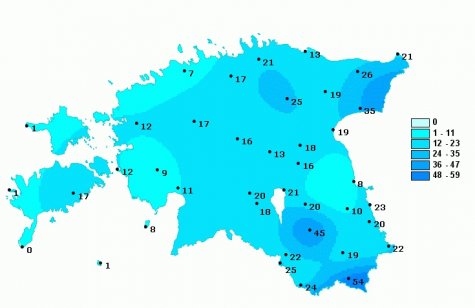South Estonia Still Enjoying Winter
Photo: Mats Kangur
Translation: Liis from forum
Massive snow cover in Haanjamaa.
The varying thickness of the snow cover brings about very different sceneries – early spring in one place, mid-winter in another. Northern Estonia already shows a patchwork of fields in a lark’s view, Haanjamaa has Christmas card snow banks. Look at the EMHI, Estonian Meteorology Institute, snow chart below: the snow cover thickness is more than half a metre in Haanja. But this half metre is only the average depth, which means that at some hidden Southern Estonian hillsides you can get stuck in snowdrifts up to the hips, if you haven’t skis on. For animals in the forests this is not a good time for running about: the late-winter thick cover is usually unpleasantly layered.
Digging a bit into a Haanjamaa snow bank turns up several different layers: first lumpy snow, then somewhat thawed snow, then an ice crust layer, then water and ice. Then snow again, and so on ... depending on how many thaw periods there have been after the first cold. Many thaw periods are preserved as ice crusts in the snowdrifts’ pattern of layers. The foot of an animal sinks through an ice crust and is cut by the ice. If you step on such layered banks with low boots and thin stockings on you can be injured in the same way if your foot goes through the crust.
But because people can use skis to carry them on the snow crust, or thick boots, this is a good time to go to south Estonia for the weekend to enjoy winter life. There is snow enough for all and surely for quite a long time. Because old folk sayings tell that if there is snow on the roof on Paastumaarjapäev, Annunciation Day, then on Jüripäev, St. George’s Day, you will still find some in the nooks of the yard. And today is Paastumaarjapäev, Annunciation day. One more memory is linked to the today’s date: the 60th anniversary of the deportations. Many things come together on this day, it is worth remembering and considering all that they signify.
EMHI snow chart: http://www.emhi.ee/index.php?ide=21,253.










